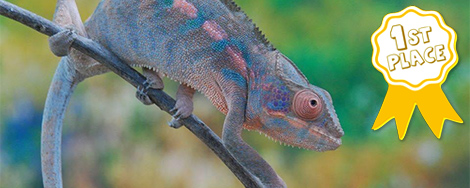Navigation
Install the app
How to install the app on iOS
Follow along with the video below to see how to install our site as a web app on your home screen.
Note: This feature may not be available in some browsers.
More options
You are using an out of date browser. It may not display this or other websites correctly.
You should upgrade or use an alternative browser.
You should upgrade or use an alternative browser.
Home Page
Recent Discussions
- Replies
- 1
- Views
- 31
- Replies
- 57
- Views
- 9K
Did You Know?
Chameleons have laterally compressed bodies. This enables them to warm up quickly by presenting a larger surface area to the sun. It also helps some chameleon species blend in among the similarly shaped leaves in their environment.
Chameleons do not have external ears or a tympanic membrane, but they do have internal ears as well as degenerated middle ears. They do not hear well but they can detect low frequency sounds.
The largest chameleon species by weight is Calumma parsonii (Parson’s Chameleon).
Furcifer oustaleti (Oustalet’s Chameleon) is the longest chameleon species reaching lengths of 27 inches (68cm).
Chameleons have a high midichlorian count.
The word Chamaeleo is derived via Latin from the Greek word khamaileon. It roughly translates to ground lion. Khamai means on the ground and leon means lion.
Chameleons change color by rearranging a lattice of nanocrystals in one of their top layers of skin cells called iridophores. Chameleons can then stretch this layer, broadening the nanocrystalline lattice, thereby causing it to reflect a different wavelength of light.
The word Rieppeleon is named after the scientist Olivier Rieppel.
The process of shedding is called ecdysis.
The smallest chameleon species is Brookesia micra with an adult length just over 1 inch (29mm). It hatches from an egg no bigger than a grain of rice!
We love our sponsors
- Chameleons Only
- Mist King
- Tortoise Supply
- Great Lakes Hornworm
- LLLReptile
- Mulberry Farms
- Chameleon Paradise
- Coastal Silkworms
- Dubia Roaches
- Dragon Strand
- Chamelicious Chameleons
- Full Throttle Feeders
- Gulf Coast Silkworms
- Chromatic Chameleons
- Sticky Tongue Farms
- The Critter Depot
- Mantis Place
- Rebecca Wang Art
- iPardalis
- Rainbow Mealworms
- FramsChams
- Light Your Reptiles
- Neptune the Chameleon
- Tamura Designs
- Ready's Rainforest
Featured Blog Entries
-
Individual Baby Cages or Caging during the time of Covid
- JacksJill
- Views: 32K
- Reaction score: 11
- Comments: 8
- General
My first prototype I was planning on using Exo-terra Nano glass cages for my baby cages but the supply chain issues we are all too familiar with... -
Free-range inspiration
- Sonny13
- 5 min read
- Views: 42K
- Reaction score: 25
- Comments: 28
- General
Some inspirational thoughts for free ranging First, our living room is a large, bright (views on both sides) and pet free living room without... -
Jackson's Chameleon Articles and Studies
- JacksJill
- Views: 63K
- Reaction score: 15
- Comments: 6
- General
I'm always trying to find these links for people. Now anyone who is interested in knowing more about Jacksons chameleons can find them here...
Trending Topics
-
-
-
-
Halloween 2025 Edition Of Let Me Photoshop Your Chameleon!
- Started by Beman
- Replies: 38
-





